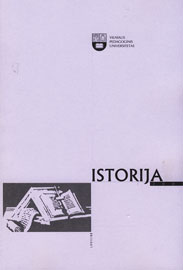Lietuvos politinių partijų jaunosios kartos radikalėjimas XX a. 4-ame dešimtmetyje
The Trends of Radicalism in the Younger Generation of Lithuania's Political Parties (the first half of the 20th century)
Author(s): Artūras SvarauskasSubject(s): History
Published by: Vytauto Didžiojo Universitetas
Keywords: Radicalism; Lithuania's Political Parties; 20th century
Summary/Abstract: The military coup of 1926 December and the authoritarian governing of Antanas Smetona weakened and almost diminished the political activities of certain Lithuanian political parties such as Lithuanian Christian Democratic Party (LCDP), Lithuanian Peasant Populist Union (LPPU) and Lithuanian Social Democratic Party (LSDP). This situation was aggravated by inner disagreements, i.e. the generation conflict, within the above mentioned parties in the fourth decade. In addition, these generation disagreements became more conspicuous within the ruling (after the military coup) Lithuanian Nationalist Union (LNU), as two decades of independence in Lithuania raised and matured a new generation of Lithuania's intelligentsia who received education in Lithuania's and foreign higher schools. The younger, dissatisfied with the political activities of the elder party members and influenced by complicated internal and foreign political affairs, demanded more rights and made claims against their parties' leadership. Consequently, the period under discussion witnessed the emergence of leftist and rightist radicalism among the pol iticians of the younger generation: the former was represented by the leftist parties, i.e. LCDP and LSDP, while the latter- by the rightist parties, i.e. LCDP and LNU. Under the influence of the international "fashion" of radicalism, the younger political opposition was far from idealizing Parliamentary democracy which was strongly supported by the elder generation; so, the left radicals turned to the East in search of supporting ideas and examples, while the right radicals - to the West. As a result, the last years of Lithuania's independence were marked by strong political and social radicalism within the above mentioned parties, especially among their younger representatives. A. Smetona's authorities, on the other hand, with the help of intelligence services and the control of public opinion, hindered the spread of radical ideals in the society thus preventing the younger generation from implementing their ideas into practice. This could be considered as a notable achievement of the authoritarian government. The adoption of the ideas of radicalism by the younger members of politicians, the ruling Lithuanian Nationalist Party included, allows to confirm the existence of an inner political crisis within many parties in the fourth decade; it deepened before the occupation. However, A. Smetona's authoritarian regime used these disagreements to neutralize the opposition (LSDP, LPPU, and LCDP) and to discipline the younger generation within their own party.
Journal: Istorija. Lietuvos aukštųjų mokyklų mokslo darbai
- Issue Year: 68/2007
- Issue No: 4
- Page Range: 43-57
- Page Count: 14
- Language: Lithuanian

